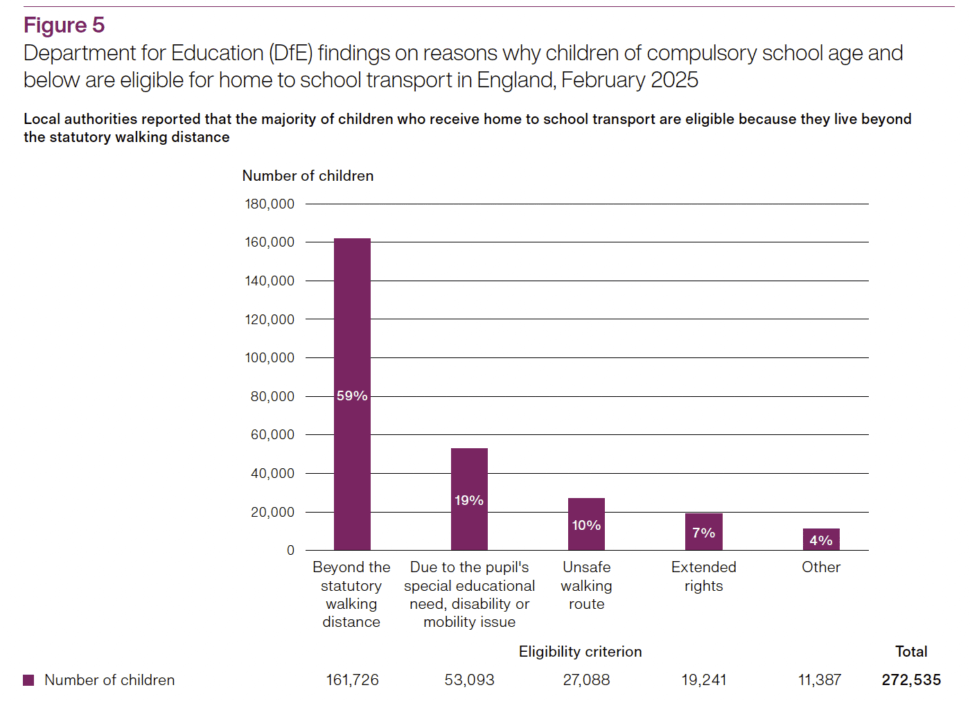Labour’s SEND reforms must address home to school transport pressures, with costs predicted to reach £3 billion by 2030, the government’s spending watchdog has warned.
The National Audit Office’s new report said councils were struggling to balance their legal duty to provide transport for eligible pupils with their duty to set a balanced budget.
Some councils are cutting back discretionary transport – including for reception aged pupils – with parents in one area expected to fork out over £1,000 to get their child to school.
It follows a damning NAO report last year calling for “whole-system” SEND reforms.
Gareth Davies, head of the NAO, said for children who relied on council transport to get to school, it is an “invaluable service”, adding that “without it, many may struggle to continue with their education.
“Local authorities are making savings to meet their statutory duties, but they are looking to DfE’s upcoming SEND reforms to ensure the long-term sustainability of home to school transport.”
Here’s what you need to know…
1. Costs could balloon to £3bn by 2030
Councils must provide free transport for school-age children who cannot walk to their nearest school due to distance, SEND or safety concerns, with extra support for low-income families.
A total of £2.3 billion was spent by councils on transport for an estimated 520,000 children in 2023-24 – a 70 per cent real terms increase since 2015-16.
This rise is mainly due to increased spending on transport for children with SEND, which rose 106 per cent to £1.5 billion compared to 9 per cent for mainstream transport.
The Department for Education estimates that on its current trajectory, spending on home to school transport for children of compulsory school age and below could exceed £3 billion by 2029-30.
In 2023-24, councils spent £415 million – 22 per cent – more than they had budgeted for on transport. This was up from £51 million – or 4 per cent – in 2015-16.
Almost half reported annual overspends of 20 per cent or more, compared to just one in five a decade ago.
Problems forcing up costs include insufficient local capacity in state special schools, and a right to “compel” councils to name out-of-area placements.
DfE data on how many pupils receive transport – only collected for the first time this year – shows that 13 per cent of pre-16 home to school transport was to an educational setting outside of a pupil’s local council area.
2. Increase in taxis
The average cost of SEND transport is about £8,116 per year compared with £1,526 for mainstream. The NAO also found a large variation between the highest and lowest cost journeys.
Pupils with more complex needs can also require specialist vehicles and sometimes specially trained passenger assistants. One council spent £145,000 in a year on one pupil.
The use of single-occupancy and private hire vehicles is increasing. A County Councils Network survey reported a 36 per cent increase in the use of cars, including taxis, for home to school transport for pupils with SEND between 2019 and 2023.
Journey times also limited opportunities for using larger, lower cost modes of transport with more pick-ups, as the DfE’s statutory guidance says in general one way journeys should not exceed 45 minutes for primary pupils and 75 minutes for secondary.
Congestion in some urban areas can exacerbate the problem. One council said because traffic was so bad, to ensure journey times did not exceed 1.5 hours for any one passenger, it could not fill its minibuses to capacity.
3. Councils cutting discretionary transport for kids
As a result of spiralling costs, councils have been scaling back their “discretionary” transport for “some time”.
All of the councils the NAO spoke to had withdrawn or restricted free or subsidised transport for sixth-formers, children below compulsory school age or those not attending their nearest suitable school.
The DfE acknowledged this may contribute to more young people not in education, employment or training.
Parents told researchers that young people with SEND losing transport could lead to parents giving up work, or working fewer hours to take their child to school or college.
One council said it charges parents £1,028 for pupils aged under five who receive home to school transport. The NAO warned this could mean pupils missing out on entire terms of reception.
But there is currently “insufficient” data to judge how any changes to home to school transport might impact attendance.
Current data shows that on-the-day issues with transport have “minimal” impact on attendance. Figures from data collected for the first time last year show only around 0.15 per cent of all missed school sessions were due to council transport issues.
DfE said statutory guidance “makes clear” councils should not have a blanket policy of never providing discretionary travel and make decisions on a case-by-case basis.

4. Funding formula doesn’t match up – but an update is coming
Currently, the Ministry of Housing, Communities and Local Government (MHCLG) uses a general formula to determine how much each council receives for home to school transport.
But MHCLG’s analysis shows the proportion of funding allocated under the formula does not align with council spending on pre-16 transport.
This is because the formula is based on residential and workplace population densities, older people’s relative deprivation and the proportion of households with children.
The NAO said these measures were “not aligned with the cost drivers for home to school transport”.
So the department is working with the DfE to develop a new funding formula for pre-16 home to school transport, which will form part of the 2026-27 local government finance settlement.
It would be based on pupil populations and distances travelled to school.
The NAO recommended the DfE monitors the impact of the funding formula on different types of authority and check whether the changes “better align funding with local need”.
5. Provider markets have not recovered since Covid
Spending increased most significantly after 2020-21 – almost three quarters of the £0.8 billion increase was transporting pupils aged 0-16 with SEND.
Councils said local provider markets had not recovered since the Covid pandemic, which impacted their ability to negotiate favourable rates.
Many drivers did not return following the pandemic, and it was “difficult to find candidates willing to work irregular hours and take responsibility for children with complex needs”.
Transport operators are also facing higher costs for fuel and wages and a reduction in public transport services has increased reliance on council-provided transport.
6. Expiring exemption could cause more issues
The NAO said some regulatory requirements designed to make vehicles safer and more accessible could also be impacting home to school transport costs.
For example, vehicles with more than eight seats require an operator license, while inconsistent taxi and private hire licensing rules across local authorities increase complexity and costs for operators.
Home to school transport vehicles are currently exempt from requirements for larger buses and coaches to be accessible for disabled passengers.
However when this expires in August 2026, NAO warns many vehicles will not be compliant and the changes could reduce the pool of vehicles and put pressure on contract costs.
7. Councils using new software and going in-house
Councils have been using “specialist software” to identify the most time and cost-effective routes, and plan journeys to enable more sharing and fewer separate journeys.
Others are introducing dynamic purchasing systems that allow suppliers to bid for available contracts at any time assuming they meet quality thresholds, helping to lower costs.
Some are expanding their in-house fleets, with one saving £870,000. But it’s not always viable if they cannot store the fleet or maintain staff.
Councils are also increasing “independent travel training” for children and young people with SEND. It aims to equip them with skills needed to travel safely on public transport or dedicated home to school services. It requires parental consent.

8. SEND reforms will be ‘central’ to reducing costs
The DfE believes that its reforms – designed to promote more inclusive mainstream schools – will be “central” to reducing home to school transport costs.
Although it acknowledges that it may be some years before any savings start to materialise, the new data collection on transport should help identify cost drivers and support benchmarking across councils, the NAO said.
The DfE is also developing supplementary partnership guidance for councils, schools and health bodies to facilitate “more joined-up decision making and ensure that travel arrangements meet needs while limiting costs”.
The NAO said the DfE should ensure the reforms and their implementation “consider implications for home to school transport to ensure the whole SEND system is delivering the outcomes intended”.
The DfE said in a statement: “We’ll set out the full schools white paper in the new year, building on the work we’ve already done to create a system that’s rooted in inclusion, where children receive high-quality support early on and at a school close to home.”






Your thoughts